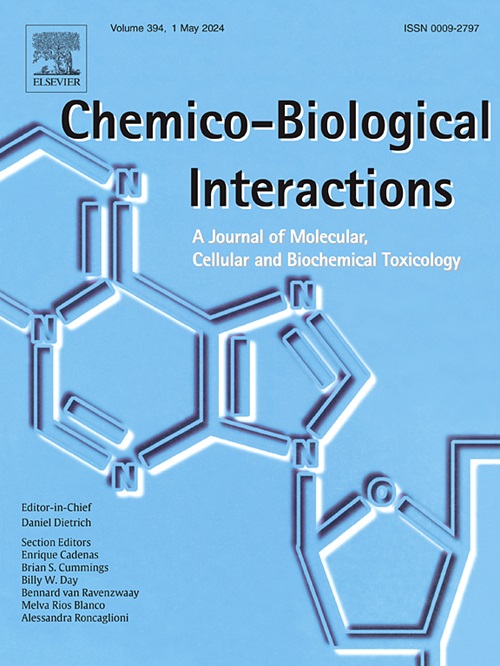Hypoxia-inducible factor-1 alpha (HIF-1α) inhibitor AMSP-30 m attenuates CCl4-induced liver fibrosis in mice by inhibiting the sonic hedgehog pathway
IF 4.7
2区 医学
Q1 BIOCHEMISTRY & MOLECULAR BIOLOGY
引用次数: 0
Abstract
Liver fibrosis is a passive and irreversible wound healing process caused by chronic liver injury. Research has shown that the upregulation of hypoxia inducible factor-1 alpha (HIF-1α) is closely related to the occurrence and development of liver fibrosis and HIF-1 α may be a promising target for the treatment of liver fibrosis. AMSP-30 m is a newly developed novel HIF-1α inhibitor by our group, which has strong anti-tumor and anti-inflammatory effects. In this study, we described the therapeutic effect and specific mechanism of AMSP-30 m on carbon tetrachloride (CCl4) induced liver fibrosis in mice. Liver fibrosis induced by CCl4 in mice and liver fibrosis induced by cobalt dichloride (CoCl2) in LX-2 cells (human hepatic stellate cell (HSC) line) were studied. Hematoxylin & eosin (H&E)and Masson's trichrome staining were used to observe pathological conditions. Western Blot, immunofluorescence and immunohistochemistry were used to detect protein expression and localization in cells, and quantitative real-time PCR analysis (qRT-PCR) was used to detect mRNA expression. Biochemical detection kits were used to detect alanine aminotransferase (ALT) and aspartate aminotransferase (AST) levels. The results demonstrated that AMSP-30 m significantly alleviated pathological symptoms, reduced ALT and AST levels, and inhibited the expression of alpha-smooth muscle actin (α-SMA) and collagen type I (COL1α1) in CCl4-induced liver fibrosis in mice. AMSP-30 m could significantly reduce the expression of HIF-1α and sonic hedgehog (Shh) pathway related proteins (Smoothened (Smo), Shh, and glioma-associated oncogene-1 (Gli-1)) in CCl4 induced liver fibrosis mice. AMSP-30 m also played a similar role in the CoCl2-induced anoxic liver fibrosis model of LX-2 cells. Further experiments showed that Cyclopamine (a Shh inhibitor) could significantly inhibit the increase of α-SMA and COL1α1 resulting from HIF-1α but not significantly inhibit HIF-1α induced by CoCl2 in LX-2 cells. And the combination of Cyclopamine and AMSP-30 m further reduced the expression of α-SMA and COL1α1 induced by HIF-1α. In summary, this study demonstrates that the HIF-1α inhibitor AMSP-30 m exerts a robust anti-fibrotic effect by inhibiting the Shh pathway, which is identified as a critical underlying mechanism. These findings suggest a promising therapeutic strategy for the treatment of liver fibrosis.
缺氧诱导因子-1α (HIF-1α)抑制剂AMSP-30m通过抑制超音hedgehog途径减轻ccl4诱导的小鼠肝纤维化。
肝纤维化是慢性肝损伤引起的被动、不可逆的伤口愈合过程。研究表明,缺氧诱导因子-1α (HIF-1α)的上调与肝纤维化的发生发展密切相关,HIF-1α可能是治疗肝纤维化的一个有希望的靶点。AMSP-30m是我组新开发的新型HIF-1α抑制剂,具有较强的抗肿瘤和抗炎作用。在本研究中,我们描述了AMSP-30m对四氯化碳(CCl4)诱导的小鼠肝纤维化的治疗作用和特异性机制。研究了(CCl4)致小鼠肝纤维化和氯化钴(CoCl2)致LX-2细胞(人肝星状细胞(HSC)系)肝纤维化。采用苏木精伊红(H&E)和马松三色染色法观察病理情况。采用Western Blot、免疫荧光和免疫组织化学检测细胞内蛋白的表达和定位,采用实时荧光定量PCR (qRT-PCR)检测mRNA的表达。采用生化检测试剂盒检测谷丙转氨酶(ALT)和天冬氨酸转氨酶(AST)水平。结果表明,AMSP-30m可显著缓解ccl4诱导小鼠肝纤维化的病理症状,降低ALT和AST水平,抑制α-平滑肌肌动蛋白(α-SMA)和I型胶原蛋白(COL1α1)的表达。AMSP-30m可显著降低CCl4诱导肝纤维化小鼠HIF-1α和sonic hedgehog (Shh)通路相关蛋白(Smoothened (Smo)、Shh和胶质瘤相关癌基因-1 (gli1))的表达。AMSP-30m在cocl2诱导的LX-2细胞缺氧肝纤维化模型中也有类似的作用。进一步实验表明,Shh抑制剂环巴胺能显著抑制HIF-1α引起的LX-2细胞中α-SMA和COL1α1的升高,但对CoCl2诱导的HIF-1α无显著抑制作用。环巴胺与AMSP-30m联用可进一步降低HIF-1α诱导的α-SMA和COL1α1的表达。总之,本研究表明HIF-1α抑制剂AMSP-30m通过抑制Shh通路发挥强大的抗纤维化作用,这被认为是一个关键的潜在机制。这些发现为肝纤维化的治疗提供了一个有希望的治疗策略。
本文章由计算机程序翻译,如有差异,请以英文原文为准。
求助全文
约1分钟内获得全文
求助全文
来源期刊
CiteScore
7.70
自引率
3.90%
发文量
410
审稿时长
36 days
期刊介绍:
Chemico-Biological Interactions publishes research reports and review articles that examine the molecular, cellular, and/or biochemical basis of toxicologically relevant outcomes. Special emphasis is placed on toxicological mechanisms associated with interactions between chemicals and biological systems. Outcomes may include all traditional endpoints caused by synthetic or naturally occurring chemicals, both in vivo and in vitro. Endpoints of interest include, but are not limited to carcinogenesis, mutagenesis, respiratory toxicology, neurotoxicology, reproductive and developmental toxicology, and immunotoxicology.

 求助内容:
求助内容: 应助结果提醒方式:
应助结果提醒方式:


